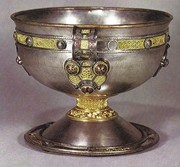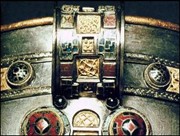Ardagh Chalice
History, Description of Silver Ecclesiastical
Bowl.
![]()
|
Ardagh Chalice |
 The Ardagh Chalice. A masterpiece of Medieval goldsmithing, and one of the great works of religious art. (National Museum of Ireland) |
Ardagh Chalice (8th/9th Century)Alongside the Tara Brooch and the Moylough Belt Shrine, as well as the Derrynaflan Chalice, the Ardagh Chalice ranks as one of the top masterpieces of Celtic metalwork art from the Irish Insular style of the eighth or ninth century CE - part of the monastic Irish art of the period. About 6-7 inches in height and 9 inches in diameter, the ministerial chalice is a two-handed silver cup, embellished with gold, bronze, pewter, enamel, and brass fittings. Other semi-precious materials used include glass, amber, malachite and rock crystal. Assembled by Celtic metalworkers and metallurgical artists from over 350 separate components, it consists of three main pieces - the bowl, the stem and the base - all held in place by a copper bolt. |
 The Ardagh Chalice (Detail) One of the greatest examples of craftwork from Celtic culture. |
|
HISTORY
OF CELTIC CULTURE METALWORK OF THE
CELTS |
Metalworking Techniques The hemispherical silver bowl is encircled with decorative panels of gold filigree, gilt bronze, enamelling and millefiori studs. The panels are decorated with zoomorphic images of animals and birds as well as geometric interlace patterns in the La Tène Celtic art style. Below the gold filigree, the names of the Apostles (except Judas) are lightly inscribed in a frieze. To make the Ardagh Chalice, forge workers and metallurgists had to master a wide range of techniques of precious metalwork. These would have included: melting down artifacts to produce scarce metals, lost-wax casting, riveting, soldering the gold filigree, handling molten glass, as well as techniques of cloisonné and champlevé enamelling. |
|
DESIGNS OF THE ANCIENT
CELTS |
Date of Construction Archeological experts are unsure of the exact date of the chalice. It may be eighth or ninth century, although the method used to join the three basic parts (bowl, stem and base) is less sophisticated than that of its sister treasure, the Derrynaflan Chalice, which suggests the eighth century. According to Celtic scholars, this example of early Christian art was probably created by metalworkers at the Clonmacnoise monastery. Discovery The Ardagh Chalice was discovered in 1868, in a field near the village of Ardagh, County Limerick, by two boys, Paddy Flanagan and Jim Quin. Inside the chalice was a smaller bronze ministerial cup and four brooches. Its discovery helped to fuel the Celtic Arts Revival movement in Victorian England. The so-called Ardagh Hoard is currently on display at the National Museum of Ireland. Between 1990 and 1995, the chalice appeared on a postage stamp issued by An Post as part of the Irish Heritage and Treasures series, to commemorate outstanding works in the history of Irish art. Other outstanding examples of Christian art from Ireland during the late Middle Ages, include the famous Tully Lough Cross (8th/9th century) found in County Roscommon, and the Cross of Cong (12th century) commissioned by Turlough O'Connor. Other famous religious works of art produced in Ireland during medieval times include the magnificent gospel manuscripts (illustrated with Celtic designs) such as the Cathach of St. Columba (early 7th century), the Book of Durrow (c.670), the Lindisfarne Gospels (c.698-700), the Echternach Gospels (c.700), the Lichfield Gospels (c.730) and the Book of Kells (c.800). |
|
• For more about Irish cultural history
and craftwork, see: Visual Arts in Ireland. ENCYCLOPEDIA OF IRISH GOLDSMITHERY AND METALWORK |